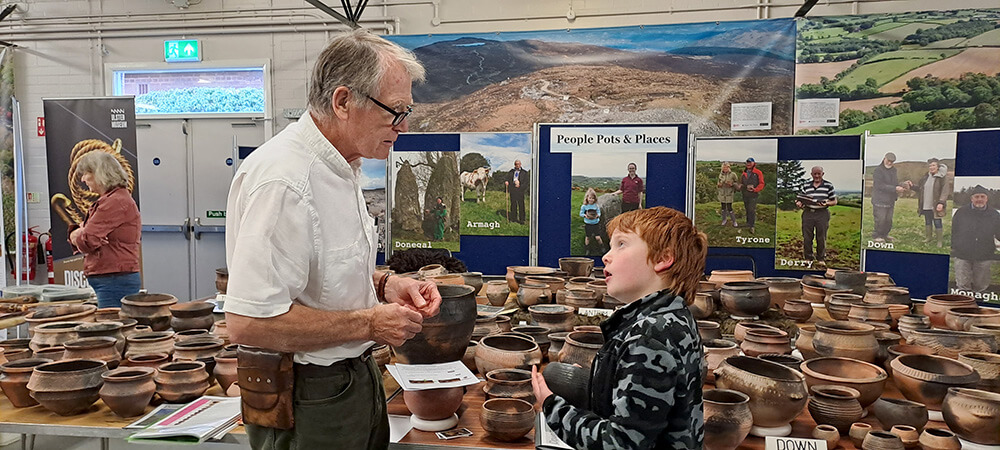
The European Association of Archaeologists’ annual conference in Belfast included an interactive program for the local community — including children — to learn about their heritage.
A profile of the European Association of Archaeologists’ (EAA) annual conference requires that you start off with a bit of history — fitting for an association devoted to discovering and preserving physical evidence of our past as a way to understand how we have evolved. Based in Prague, Czech Republic, EAA was founded after the fall of the Berlin Wall, with the goal of bridging Western and Eastern archaeological research and heritage management. With members from nearly 70 countries, EAA, the second-largest archaeological association in the world, gathers members together annually in different European destinations.
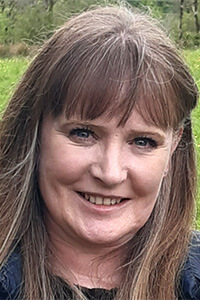
Eileen Murphy
Through its Northern Ireland Ambassador Program, Visit Belfast worked with Eileen Murphy, professor of archaeology, School of Natural and Built Environment at Queen’s University Belfast, to successfully bid for the 29th EAA Annual Meeting, which received subvention funding from Belfast City Council and Tourism Northern Ireland. The conference was supposed to be held in Belfast in 2022 but was moved to the following year to accommodate Budapest, which was ahead of Belfast in a rotation disrupted by the pandemic.
“We were happy enough to move to 2023,” Murphy, who also served as the head of the event’s scientific committee, told Convene. “It made it all more special because it was the 25th anniversary of the Belfast Good Friday Agreement,” an agreement between the British and Irish governments on how Northern Ireland would be governed. The event in Belfast, Aug. 30–Sept. 2, was supported by Conference Partners International’s “fantastic team,” Murphy said.
There was a last-minute shift in the hybrid event’s attendance ratio — approximately 3,000 in-person delegates and another 500 delegates online — because of a few hiccups, including a problem with U.K. airspace the day before the conference that prevented some participants from traveling to Belfast. In addition, she said, “we had a lot of delegates coming from all over the world who tried to get flights into Dublin and then their visas weren’t current because of the whole Brexit issue. Some people had to go home. It was a bit of a fiasco in that sense, but it was one of those force majeures that we couldn’t do anything about.
“Thankfully, it was hybrid, so at least they could convert to that,” Murphy said. EAA is committed to having an online event option, she added, because it makes its education sessions accessible for those who can’t travel for whatever reason. “It means they can still be involved in the big events without having to physically be at the conference,” she said. “I see it as a positive.”
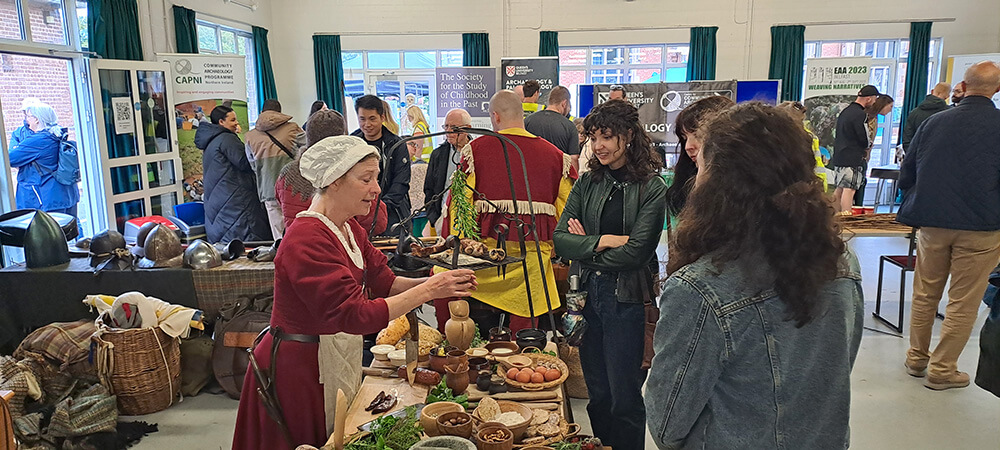
During a pre-conference festival at Queen’s University Belfast, heritage groups shared their knowledge with more than 900 visitors to the event.
Public Assemblage
A festival held right before the face-to-face conference drew the local community. “Everybody knew we were here because there was so much signage up around the campus, there were so many delegates, and there was a real buzz,” Murphy said. With a Centre for Community Archaeology as part of her department at Queen’s, she said, “we’re very keen to be promoting heritage to the general public and to as wide an audience as possible. We were conscious that the conference was very much an academic event, but we wanted to have a public-engagement component. We linked in with our Queen’s Film Theatre [an independent cinema at Queen’s University] and we had a festival of archaeology films in the few days leading up to the conference.
“Then on the Sunday, just before the conference, our Centre for Community Archaeology staff organized a festival [in a hall at the university]. We got lots of different heritage stakeholder groups from community archaeology, commercial archaeology, the museums, and the government sector. We had an amazing festival. I think we had over 900 people come in and visit us and we had lots of experiential archaeology. It was just really to celebrate the event coming, but also an opportunity to tell people more about the lovely heritage and archaeology of Northern Ireland.”
Living history actors mingled with the crowd, and one of Murphy’s colleagues made replica pots, which were sold to raise funds for a homeless charity. “There were lots of different elements like that,” Murphy said. “We tried to then keep those running during the conference. It was in one big hall and the delegates could go into that as a bit of a bonus because we hadn’t really promoted that this was happening. It just gave them a chance to go and chat to some of the people from here about the local archaeology. I think people got a lot out of it. They went in and everyone came out with a smile after they met the living history reenactors, and were able to have a go at wielding their swords.”
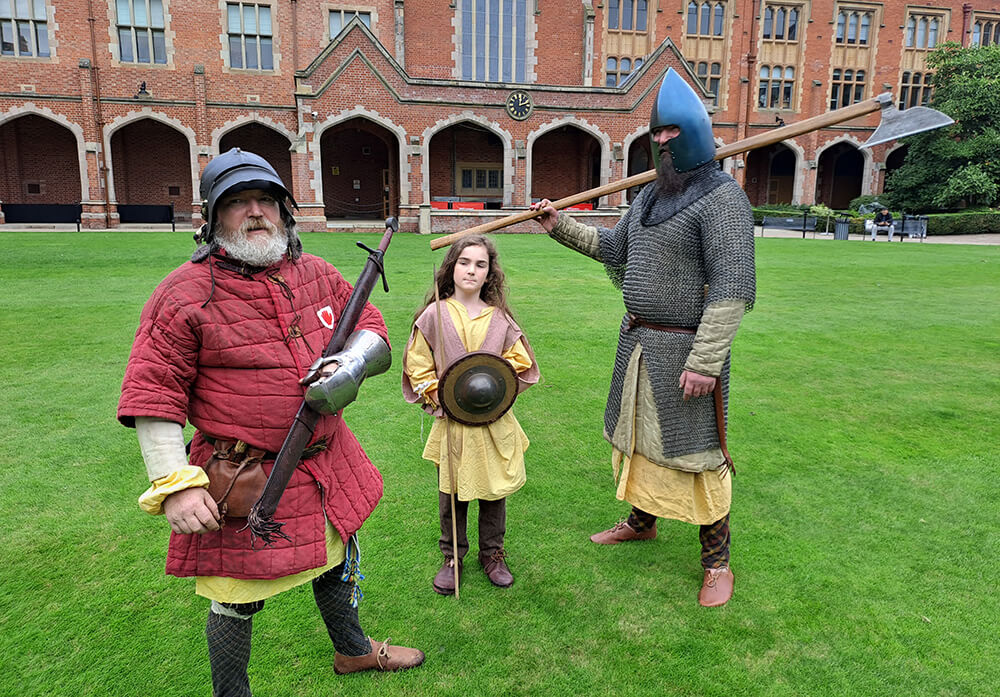
Historical reenactors brought Ireland’s archaeology to life for participants and the local community.
Digging up the Past
Murphy said she was “heartened” to see that her own interest in childhood archeology — the study of juvenile human individuals in past societies from a material perspective, an area that has been overlooked — was reflected throughout the program. In addition to sessions focused on childhood archeology, one of the prizes the association presents at its annual event was given to a childhood archaeology book and a student prize was awarded for a paper on childhood archaeology. “That was definitely a theme that had been neglected until maybe the last 10, 15 years,” she said, “and now it’s really coming to the fore.” Murphy said that “one of the beauties” of EAA’s conference is its variety of specialized session content and formats.
“You can have a very large all-day session, or you can have a bespoke session that just lasts for half a day or a quarter of a day,” she said. “It means people of like mind have a chance to get together and really focus in on particular areas. Overall, I think we had almost 300 sessions.”
Site Work
One of the challenges for organizers “was trying to find enough rooms on our campus and enough big rooms for the larger sessions,” Murphy said, “but I think we did it. We put a lot of effort into our signage to try and just make sure people could move around between sessions.”
Housing accommodations “was one of my worries early on,” Murphy said, and ended up being “a real mix” — several hundred stayed on campus at Queen’s and another several hundred at its affiliated Stranmillis College, taking advantage of that window of opportunity for large events to take place between semesters at universities when there are no students. In addition to a few hotel blocks, “resourceful” delegates found apartments to rent and Airbnbs, she said. “That was something I was expecting because quite a number of the hotels are filled with refugees still, especially in and around the university area. When we planned the conference in 2018, the capacities were quite different. We would have had access to maybe three or four hotels in the immediate vicinity of the university that were now not available to us.”
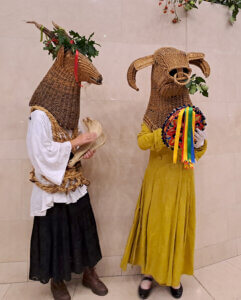
The Armagh Rhymers, a performing group that keeps alive the Irish tradition of Mumming, were part of the opening ceremony at International Convention Centre Belfast.
Field Exploration
Pre- and post-conference tours gave participants a chance to experience Northern Ireland’s rich history, including all-day tours to ancient monasteries in County Fermanagh, trips to Belfast City Cemetery, Ulster Folk Museum, archeological sites like Navan Centre & Fort, the medieval Dunluce Castle, and awe-inspiring natural attractions like the Giant’s Causeway. “They also went out to the Giant’s Ring,” Murphy said, “which is an amazing site just outside Belfast, a big prehistoric henge monument.” Walking tours of Belfast cast a spotlight on the archeology of Belfast — “today it’s very much a Victorian city,” she said, “but there’s a whole medieval layer that’s beneath the ground that people don’t really know about.” There were also trips to Tara and Newgrange in County Meath and the National Museum of Ireland in Dublin, “because we wanted a cross-border aspect as well.”
Human Activity
The opening ceremony at ICC (International Convention Centre Belfast), which included young performers of traditional Irish and Highland dance, was an opportunity to immerse attendees in Irish culture through edutainment. A highlight for Murphy was the Armagh Rhymers, a performing group that keeps alive the several 1,000-year-old Irish tradition of Mumming, where characters wearing intricate wicker masks perform drama, song, and dance routines.
“One of them is an archaeologist, James McKee, who was all dressed in this man of the wild [costume], covered in plants, and he had a huge replica Iron Age horn,” Murphy said. “He came out with it at the end and that ended the ceremony. He then went out into the reception area and people in the audience followed him. That’s where all the wine and festivities were.” It made an impression on the group, Murphy said, not only because it was primal and visceral, it also “sort of taught archaeology.”
‘They’ve Got the Bug’
Queen’s University’s Eileen Murphy said the EAA conference in Belfast benefited from the on-site assistance of “amazing student volunteers” from the Queen’s campus and all over the world “as well as our local Ulster Archaeological Society. It really was a big team effort.”
But the students benefited from the experience even more. Before the event, Murphy said, “I was torturing our students and saying, ‘Oh, you have to get involved.’ They didn’t really know what it was about, but afterwards, so many of them have said, ‘We’re so glad you pushed us because it was brilliant.’ I don’t think they had really imagined the scale of an event like that. It really was a good learning experience.
“I think a lot of them now are all keen to go to Rome, which is where EAA is next year. They’ve got the bug and they realize they can learn academically, but it’s also important for the networking. I wouldn’t have known anything about conferences when I was an undergraduate, but now all these guys really do, and they’re fully engaged. They’ve bought into it.”
ON THE WEB
Learn more about the EAA 2023 Annual Meeting in Belfast at e-a-a.org.
